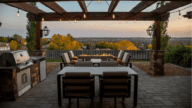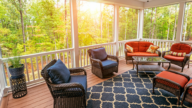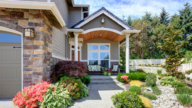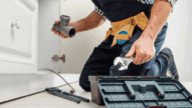Top 9 Renovations to Increase Home Value in 2026
- Published on
- 10 min read
-
 Emma Woodward, Contributing AuthorClose
Emma Woodward, Contributing AuthorClose Emma Woodward Contributing Author
Emma Woodward Contributing AuthorEmma Woodward is a freelance writer who loves writing to demystify real estate and finance topics. She is always looking for tactics to connect with readers in a non-stuffy way. When she's not writing about budgeting or mortgages, Emma also writes about food and fashion. She has written for companies and publications like Finch, Toast, Bankrate, and The Financial Diet.
Based in the Seattle area, Emma enjoys discovering new hiking trails and outdoor wonderlands when she's not working. You might also find her reading a good book, searching out a tasty bake shop or wandering through her neighborhood.
-
 Joseph Gordon, EditorClose
Joseph Gordon, EditorClose Joseph Gordon Editor
Joseph Gordon EditorJoseph Gordon is an Editor with HomeLight. He has several years of experience reporting on the commercial real estate and insurance industries.
With mortgage rates expected to be under 6% by 2026, more buyers will be in the market — and homeowners can make smart upgrades to get top dollar. Whether you’re gearing up to sell or simply want a better living space, knowing which renovations increase home value is key to getting the best return on your investment.
In this blog, we’ll break down the improvement projects that offer the biggest impact, so you’ll know which projects to prioritize in the new year, because in today’s market, every dollar counts.
Renovations that will increase home value in 2026
Home renovations are a significant financial commitment. To put it in perspective, updating a 1,250 to 1,600 square-foot home typically costs around $52,219, though minor projects can run as little as $3,000, while full-scale renovations may reach $190,000.
With costs this high, careful planning is essential. Some upgrades offer strong returns, while others may not recoup their expense. By understanding the typical return on investment (ROI) for common improvements, you can make smarter choices and maximize the value of every dollar spent.
“I can tell you the average ROI for updating or remodeling a home: you get back seventy-four cents for every dollar invested on average,” adds Peter Clark, who works with over 69% more single-family homes in the Portland, Oregon area.
If you want to improve your property value, consider these investment-worthy renovations:
1. Boost your curb appeal
Curb appeal always gives buyers an important first impression and can get them excited about the home as soon as they drive up. According to JLC’s 2025 Cost vs. Value Report, eight of the ten top-return projects are exterior upgrades, emphasizing the lasting impact of curb appeal.
That said, focus on these top exterior home improvement projects:
- Replacing the garage door: One of the most visible upgrades, it can recoup 268% of its cost while instantly boosting curb appeal.
- Updating your entry door: A stylish and secure front door can recover 216% of its cost, making it a high-impact, low-effort improvement.
- Upgrading your siding: Using stone veneer not only enhances your home’s look but also returns 208% of the investment.
At the same time, don’t forget the essential curb appeal projects:
- Landscaping: Refresh the lawn and garden. Keep the grass trimmed, add fresh mulch, and plant seasonal flowers for a vibrant look.
- Lighting: Install exterior lighting. Use pathway lights or wall sconces to highlight your home’s features and improve nighttime safety.
- Exterior maintenance: Power wash surfaces. Clean the driveway, walkway, and siding to remove dirt and give your home a freshly maintained appearance.
- Decor and accents: Add stylish details. Incorporate potted plants, a new welcome mat, or updated house numbers to tie the look together.
Karin Provencher, a top real estate agent in Manchester, New Hampshire, says that new siding or trim often adds about 5% to 10% in value because it changes the house’s look.
Vertical board and batten siding, which costs an average of $4,000 to $14,000, can create a modern farmhouse look that’s especially striking with black trim.
Toss in some lighting on the walkways or driveway to “really capture a buyer’s heart,” she says.
2. Create a more functional floor plan
Livable square footage often increases your appraised value.
“More and more floor plans that don’t work as well nowadays are getting more and more pushback,” according to Santiago Valdez, a Chicago agent with over two decades of real estate experience. Standalone kitchens or bathrooms on the smaller side are seen as outdated, and buyers aren’t as willing to make them work as they used to be.
Consider reworking the floor plan or adding additional space to make the home more functional for modern living. Valdez recommends you consider features like these:
- Large bathrooms
- Kitchens connected to other rooms
- Walk-in closets
- Additional prep space for kitchens
If you have an unfinished basement, adding flooring, drywall, and other touches to make it a livable space has a potential ROI of 70%. Convert it into a living area or a “specialty room” that buyers love.
If you can’t add more space to the home, make it more functional by converting unused spaces. Consider turning an unused home office into a bedroom or reworking an unused living room into a flex space.
Before you grab that toolbox, remember — it’s not just knowing which upgrades add value, but which ones can actually drag it down. Some projects look great but end up being money pits. Check out our guide to find out which home improvements don’t add value so you can avoid them and focus your money where it really pays off.
3. Upgrade to luxurious bathrooms
Buyers are looking for bathrooms that feel like a spa experience. About 18% of agents said that the second most sought-after feature for buyers is modernized bathrooms (and kitchens), as reported in HomeLight’s Top Agent Insights Q3 2025. Remodeling this space can increase property value by as much as 74% of the renovation cost.
Consider upgrades such as rain shower heads, double-sink vanities, extra storage, soaking tubs, and anything else that contributes to a modern, spa-like experience.
Valdez says that buyers want more spacious bathrooms than they had before. Look for ways to create the illusion of more space by adding mirrors or reworking the floor plan. If your budget permits, consider adding more square footage when remodeling your bathroom.
4. Install a kitchen island or walk-in pantry
For 17% of agents surveyed by HomeLight, minor kitchen updates provide the highest ROI for boosting both a home’s sale potential and its final price. In JLC’s report, a minor, mid-range remodel recovers 113% of the investment. That said, consider adding multiple sinks, a new refrigerator, and a flexible pantry space.
“The kitchen has always been a very central space [in] the home. Especially on new construction, we are seeing more and more prep space in the kitchen,” says Valdez.
5. Build or convert a home office
If you’re not much of a cook, consider converting an existing walk-in pantry (or closet) into a home office. In Provencher’s experience, just having that devoted space is a bonus.
“It definitely helps to edge out your competition,” she says. “I recently showed a condo that had a big walk-in pantry with their office in it. They could keep the door open if needed, but it was a nice little private space on the first floor where everything’s happening,” she adds.
She’s also seen homes where sellers have removed the clothing racks in a double closet and put in a tabletop and adjustable shelving for office space. This type of conversion fits well in a guest room but is also an efficient way to use the closet in a baby’s or toddler’s room, where a small dresser or wardrobe can handle the child’s clothing.
“The kids can be in a play space while you’re working, and at the end of the day, you can close it up and be done with it,” she says. “I’ve shown a few homes with it, and everybody is like, ‘Wow, this is so great.’”
6. Expand your outdoor space
Improved outdoor or garden spaces serve as a big selling point for buyers in 2026. Consider incorporating any of these sought-after features:
Pool
Homeowners in certain parts of the country can increase their home’s value by up to 7% if they add a pool. Building a pool can make financial sense if you live in a warmer climate area, like Florida or California, or in a neighborhood where most other houses have pools.
However, adding a pool isn’t always the right call. The added expense and maintenance upkeep might outweigh any potential ROI a pool could yield. Consult a real estate agent to determine if adding a pool will leave you high and dry.
Deck or patio
Decks gained greater popularity due to the pandemic and can boost your home’s value. While costs vary based on materials and size, you could recoup between 89% to 95% of your costs if you decide to build a deck. The average cost to add a wood deck in 2025 is $18,200. A composite deck costs about $25,100.
Hot tub
An in-ground hot tub can turn your backyard into a luxurious spa-like retreat, especially with a pool. It might not pay back the full $8,000 to $25,000 cost, but in the right neighborhood or for buyers who love luxury touches, it can boost your home’s appeal and maybe even its value.
A freestanding hot tub isn’t a bad compromise if you’re shy about breaking ground. While freestanding hot tubs aren’t factored into a home’s overall value (appraisers consider them personal property), your agent can discuss with the buyer paying for it separately.
Big home upgrades aren’t the only way to boost value. Sometimes, it’s the little changes that make the biggest difference. From quick fixes to smart updates, a few small projects can totally transform your space. Read our guide to discover the small, budget-friendly upgrades with high ROI.
7. Modify your home for aging-in-place or intergenerational living
With about 84% of older Americans wanting to age in place and 58% saying it’s extremely important, many are staying put or making updates to better suit their needs. For sellers, this trend highlights the value of features that support flexible, multigenerational living.
Adding an accessory dwelling unit (ADU) is one way to attract buyers, provide space for extended family, or even generate rental income. It can also increase a home’s value, making it a smart investment for those looking to sell quickly and maximize their return.
“Multigenerational living is a huge value-add,” Provencher says, boosting the typical home value in her area by about 20% to 25%. She says that even people who don’t plan to use an ADU as housing love the space as a home office suite.
However, building an ADU can get expensive. The average cost is $180,000, but it can stretch up to $360,000. The cost can be impacted by the type of ADU you build, the material type, the design of the space, labor costs, and the systems you equip the unit with.
8. Make your mudroom bigger and more functional
A mudroom or foyer with a place to drop off the day’s gear has long been a home design perk, especially in areas where corralling wintery shoes and boots is a must. Adding this space to your home offers approximately 50% ROI.
Provencher says that adding a bench, hooks, and built-in cubbies to a small foyer entry creates this natural stopping point and a perceived value-add.
“They want that drop zone,” she says.
9. Introduce small, but impactful changes
According to Valdez, ensuring the home doesn’t show signs of “deferred maintenance” will give you the best ROI. These changes don’t have to be big renovations. They can be small updates to the home, including:
- Cleaning up the property
- Adding fresh paint
- Fixing windows with leaks
- Repairing any gas leaks
- Resanding floors
- Updating old or outdated appliances
- Filling in caulk or grout that needs repair
The renovation project with the highest potential ROI? Refinishing wood floors. You can recoup 147% of the costs for this project.
If you have a low budget or little time to make renovations, consider these small to-dos to help boost your home’s value.
Renovations can be expensive, so invest wisely
Not every renovation project will increase your home value. But keeping pace with what buyers want can help increase your resale value.
Talk with a local real estate agent about which renovations increase home value in your area, and then see which ones can help you enjoy your space the most until you’re ready to hit the market.
Header Image Source: (Petra Keßler / Unsplash)








